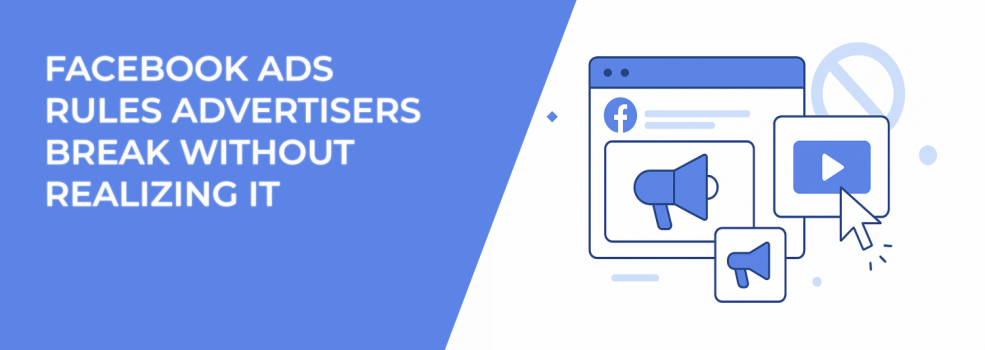unning Facebook ads is already complicated enough. You juggle targeting, budgets, creatives, and optimization. But what if the real problem isn’t in your strategy at all, but in the rules you might be breaking without realizing it?
Facebook has strict advertising policies, and even small mistakes can hurt your reach, cost you money, or get your ads rejected altogether. In some cases, repeated violations may even get your account restricted or permanently banned.
Below are the most common Facebook Ads rules advertisers unknowingly violate — with detailed explanations, examples, and practical tips for staying compliant.
1. Misleading or Overpromising Claims in Facebook Ads
Marketers love strong, persuasive copy. But sometimes it crosses the line into exaggeration. Promises like “Lose 10 pounds in 7 days” or “Earn $5,000 a week working from home” sound tempting, but Facebook views them as misleading. Even if a few people achieved those results, the platform considers those claims unrealistic for the general audience.
A real scenario: imagine promoting a skincare product. If you claim “Eliminates wrinkles overnight”, your ad is almost guaranteed to be disapproved. Instead, you could say, “Customers report smoother-looking skin after consistent use.” That’s accurate, believable, and still attractive.
If your ads still aren’t converting even after cleaning up your copy, check out Facebook Ads Not Converting: How To Fix It.
2. Using Personal Attributes in Facebook Ad Copy
This is one of the most common violations — and many advertisers don’t even realize they’re breaking the rules. Facebook prohibits ad copy that implies you know personal details about the user, such as age, health, ethnicity, income, or relationship status.
For example, saying “Are you suffering from anxiety?” or “Single moms in Chicago are loving this offer” is not allowed. Even if your targeting settings reach that exact group, your copy cannot call them out directly.
A safer version: “Discover proven ways people manage stress” or “Find support and resources for parents balancing busy lives.” Both phrases address the same topic but without invading personal boundaries.
If you need help finding safer, more effective targeting approaches, see Facebook Ad Targeting 101: How to Reach the Right Audience.
3. Violating Facebook’s Restricted Content Rules
Some industries walk a tightrope with Facebook ads — finance, health, alcohol, dating, housing, politics, and supplements are just a few. Facebook applies extra scrutiny to avoid scams, discrimination, or offensive content.
For instance, an investment company advertising “Get 300% returns in crypto this month” will almost certainly be flagged. A safer approach might be “Learn strategies top investors use to grow their portfolios.” Still valuable, but not exaggerated.
In the health space, even innocent phrases like “before and after” can cause problems. A fitness brand showing dramatic weight-loss photos risks immediate rejection. Instead, showcase active lifestyles, community support, or customer stories without extreme transformations.
For a deeper breakdown, you’ll want to read How To Avoid Ad Rejection On Facebook: Meta Ad Policies Explained.
4. Ignoring Facebook Ad Formatting and Technical Guidelines
Sometimes an ad gets rejected even though it doesn’t break any content rules. Why? Because of formatting or technical errors.
A common mistake is uploading images with too much text overlay. While Facebook no longer enforces the “20% text rule” strictly, ads with heavy text still perform poorly and may be deprioritized. Another frequent issue is broken links or slow-loading landing pages — Facebook penalizes ads that send people to a bad experience.
Real-world examples:
-
A clothing brand uses a square image instead of the recommended 1080x1920 vertical format for Stories. The ad runs but looks awkward, wasting impressions.
-
An advertiser links to a landing page with a pop-up that doesn’t load on mobile. Facebook flags it as a “poor user experience.”
A well-formatted ad won’t just pass Facebook’s rules. It will also convert better.
5. Breaking Facebook Targeting Rules Without Realizing It
Targeting is where many advertisers get tripped up. Some categories — housing, credit, employment — require special targeting restrictions to prevent discrimination. If you try to exclude or narrow down groups unfairly, Facebook may block your campaign.
Even outside those categories, hyper-targeting can backfire. For example, if you layer multiple filters (age, gender, interests, behaviors), your audience size shrinks too much. Facebook then struggles to deliver your ad, and you risk breaking policies without intending to.
Safer alternatives:
-
Use lookalike audiences built from your existing customers.
-
Create custom audiences from engagement (people who visited your site, watched your videos, or interacted with your posts).
-
Let Facebook’s algorithm optimize delivery within broader audience ranges.
To dive deeper into audience building strategies, see How to Define a Target Audience for Marketing: a Step-by-Step Guide.
6. Forgetting to Review Facebook Advertising Policy Updates
Facebook quietly updates its ad policies several times a year. What passed a few months ago might now be flagged. Yet many advertisers never check the updates until their ads stop running.
For example, privacy changes have made certain targeting options disappear. Terms like “multicultural affinity” or sensitive health categories were once available but later removed. Advertisers who relied on them suddenly found their campaigns rejected.Staying informed prevents last-minute surprises and keeps your campaigns future-proof.
Final Thoughts
Breaking Facebook ads rules without realizing it is more common than most advertisers think. Misleading claims, personal attribute misuse, restricted content, formatting errors, targeting mistakes, and outdated practices all add up to wasted money and lost opportunities.
Compliance isn’t just about avoiding rejection. It’s about building trust, creating stronger campaigns, and ensuring your ad spend brings results instead of frustration.
So before you launch your next campaign, ask yourself: are my ads not only persuasive but also policy-proof? That one step could save you hours of headaches and hundreds of dollars in wasted budget.

